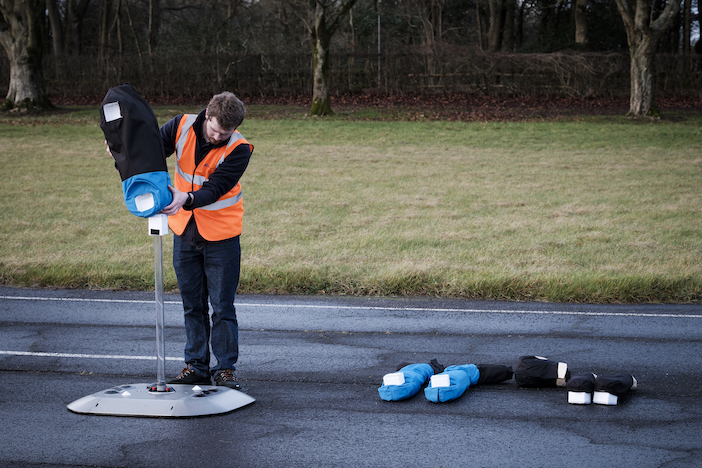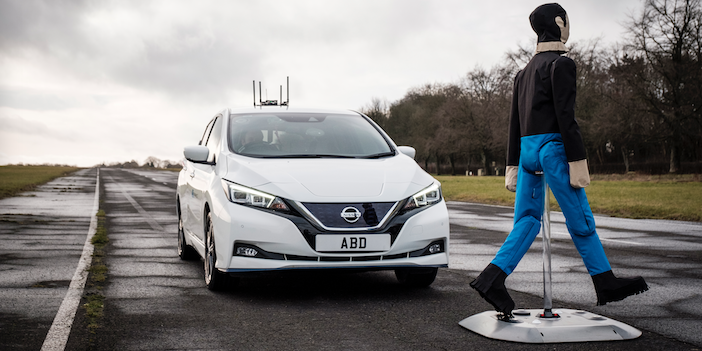AB Dynamics, an automotive testing technology supplier, has collaborated with sister company Dynamic Research, Inc. (DRI), to launch a next-generation pedestrian ADAS target, named the Soft Pedestrian 360. The target has been developed to support tests for improved sensor perception and categorisation, as well as to decrease the time and cost of testing through improved robustness.
Realism is key to accurate simulation, so the Soft Pedestrian 360 has been enhanced with sophisticated articulation of the knee, hip, shoulder and neck. The actively articulated knees enable the hip and knee to move independently of each other, control the gait and, say the partners, allow a greater and more varied range of movement to be reproduced than is possible from a passive system. DRI says this combination of factors is critical for vehicle sensor systems to ensure the correct categorisation of a pedestrian.
“Properly representing the stance phase of the gait, when the foot is stationary relative to the ground, can be a critical factor in an AEB [autonomous emergency braking] system’s categorisation of the target as a pedestrian,” explained Joseph Kelly, chief engineer at Dynamic Research, Inc. “Without this attribute, an AEB system could mis-categorise the target as something other than a pedestrian and react differently. The team at DRI researched gait characteristics to identify and recreate the correct knee and hip articulation angles as functions of percent of gait cycle.”

The gait is automatically synchronised with the position, speed and acceleration of the target relative to a starting point using the platform’s IMU (Inertial Measurement Unit). This method prevents a phenomenon that the team has termed as “Flintstoning”, where the foot in the stance portion of the gait is not stationary relative to the ground, and results in better characterisation.
“Damage to the vehicle under test caused by targets can be a substantial contributor to the total cost of testing ADAS technologies,” added Kelly. “It isn’t just the damage to the test vehicle but also lost track and engineering time waiting for repairs that substantially increase the cost of testing. For example, if a windshield is damaged, camera systems located behind it often require recalibration, which is time-consuming and costly. We have specifically designed the Soft Pedestrian 360 to minimise the risk of damage to the test vehicle.”
The key to reducing the potential for damage to the test vehicle are the target’s compliance, the minimisation of external hardpoints and the modularity of the design, which reduces the mass of any individual component that could contact the test vehicle and cause damage. The limbs, head and mounting pole are attached to the torso via foam blocks that engage corresponding sockets in the torso, such that when these components separate on impact, there are no exposed hard points that can damage a vehicle.
The servos operating the limbs and the head of the pedestrian are also completely encased in foam and sit within each component. This means that the vehicle under test is protected when the limbs disconnect upon impact.

The durability of the product has been improved using a slipper clutch that stops the servos from being back-driven during a collision, again helping avoid damage. The target is also covered in a hard-wearing fabric clothing that prevents the foam core from being worn away or torn apart, maintaining a consistent shape throughout testing. The clothing can be easily and cost-effectively replaced should it become damaged.
“Efficient use of track time is critical to keeping costs down, and maximising the uptime of both the test vehicle and the test equipment is a critical part of this,” said Kelly. “Before we developed our own pedestrian target, we were regularly changing and repairing servos as a result of damage and this significantly impacted the test schedule. Our solution aims to make ADAS testing as efficient as possible.”
The modular design of the Soft Pedestrian 360 means the articulating arms and head can be swapped for static units, for example when conducting Euro NCAP tests where articulation isn’t required. This provides a simplified and cost-effective configuration option when active articulation isn’t required, but provides the opportunity to increase realism where necessary.
The limbs and head can also be changed to increase the variety of testing. For example, the prescriptive head used for NCAP and NHTSA tests can be changed for an active unit for development work, or the arms changed to represent a pedestrian using a cell phone.





